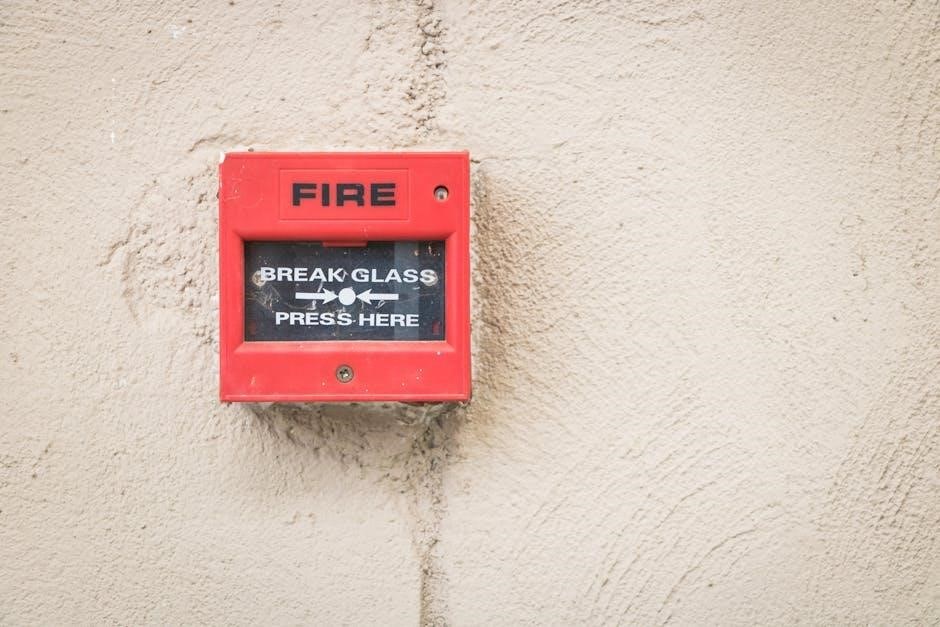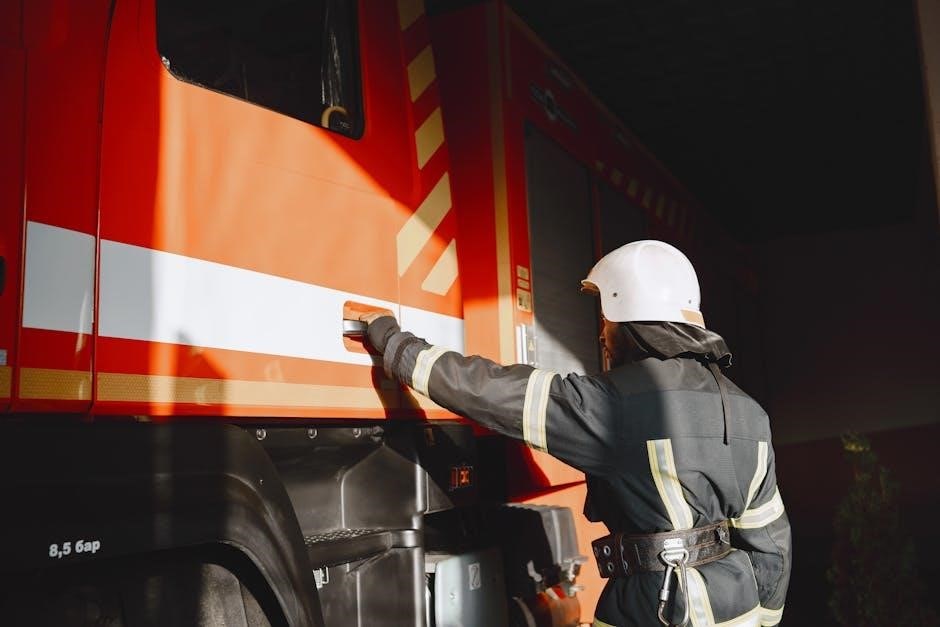first alert manual
Lost your First Alert manual? No sweat! Download the PDF, troubleshoot like a pro, and keep your home safe. Get the First Alert manual now!
First Alert Manual: A Comprehensive Guide
Welcome to your comprehensive guide to First Alert manuals.
This resource is designed to help you navigate the world of
First Alert safety products. From smoke alarms to security systems‚
understanding your device is crucial. Let us help you gain insight
into your First Alert device!
Understanding First Alert Smoke Alarms
First Alert smoke alarms are essential for home safety‚ providing early
warnings of potential fires. These devices are designed to detect smoke
particles‚ offering crucial time for evacuation. Understanding how these
alarms work is paramount for effective protection. All First Alert smoke
alarms conform to regulatory requirements‚ including UL217‚ ensuring they
meet strict safety standards. They are designed to detect particles of
combustion‚ giving you peace of mind.
It’s important to note that a smoke alarm can only sound an alarm once
smoke reaches the sensor‚ highlighting the significance of proper
placement and maintenance. These alarms are not combustible gas detectors
or carbon monoxide detectors‚ so ensure you have the appropriate detectors
for each hazard. For optimal performance‚ regularly test your alarms and
replace batteries as needed. Familiarize yourself with the user manual for
specific instructions and limitations to maximize the effectiveness of your
First Alert smoke alarms. Reading the manual will ensure you are kept
safe.
Regulatory Compliance and UL217 Standard
All First Alert and BRK smoke alarms adhere strictly to regulatory
requirements‚ most notably the UL217 standard. This compliance ensures
that these devices meet specific performance criteria for detecting smoke
and providing timely alerts. The UL217 standard sets benchmarks for smoke
alarm sensitivity‚ reliability‚ and resistance to false alarms.
Manufacturers must undergo rigorous testing and certification processes to
demonstrate adherence to these standards. This certification guarantees
that the alarms perform as expected‚ giving homeowners confidence in their
safety.
Regulatory compliance extends beyond just the UL217 standard‚ encompassing
other federal‚ state‚ and local regulations. These regulations cover
various aspects of smoke alarm design‚ manufacturing‚ and installation.
First Alert’s commitment to meeting these standards underscores their
dedication to providing reliable and safe products. Understanding the
importance of regulatory compliance and the UL217 standard helps consumers
make informed decisions when selecting smoke alarms for their homes. Always
check for UL217 certification when purchasing a smoke alarm.
Smoke Detection Technology in First Alert Alarms
First Alert alarms employ advanced smoke detection technology to ensure
early and reliable fire detection. These alarms are designed to detect
particles of combustion‚ alerting occupants to potential fire hazards.
There are primarily two types of smoke detection technology used in First
Alert alarms: ionization and photoelectric. Ionization smoke alarms are
generally more responsive to fast-flaming fires‚ while photoelectric smoke
alarms are typically more sensitive to slow-smoldering fires.
Some First Alert alarms incorporate both ionization and photoelectric
sensors for comprehensive fire detection. These dual-sensor alarms provide
enhanced protection against a wider range of fire types. The specific
technology used in each alarm model is detailed in the user manual.
Understanding the type of smoke detection technology used in your First
Alert alarm can help you choose the right alarm for your specific needs.
Regular testing and maintenance are essential to ensure the continued
effectiveness of the smoke detection technology. Refer to your user manual
for instructions on how to properly test and maintain your alarm.
First Alert Security System Manuals
First Alert offers a variety of security systems designed to protect your
home and family. Each security system comes with a detailed user manual
that provides comprehensive instructions on installation‚ operation‚ and
maintenance. These manuals are essential for understanding the features
and benefits of your specific security system model. The manuals cover
various aspects‚ including system components‚ keypad functions‚ sensor
placement‚ and alarm settings.

The First Alert security system manuals also provide guidance on
troubleshooting common issues and maintaining the system’s optimal
performance. You’ll find information on how to disarm the system‚ manage
entry delays‚ and respond to alarm events. Additionally‚ the manuals
include safety precautions and warnings to ensure proper usage and prevent
accidental alarms. It is crucial to carefully read and understand the
manual before operating your First Alert security system. Keep the manual
in a safe and accessible location for future reference. If you have
difficulty locating your manual‚ visit the First Alert website or contact
customer support for assistance.
Navigating the User Manual

User manuals for First Alert products are designed to be informative and
user-friendly‚ but sometimes navigating them can feel overwhelming. The
key is to understand the structure and where to find the information you
need. Start by familiarizing yourself with the table of contents. This
will give you an overview of the topics covered and help you quickly
locate specific sections. Pay attention to headings and subheadings‚ as
they break down the information into manageable chunks.
Look for keywords related to your specific question or issue. Most
manuals include a glossary of terms‚ which can be helpful if you encounter
unfamiliar vocabulary. Diagrams and illustrations are often included to
visually explain concepts and procedures. When troubleshooting‚ refer to
the troubleshooting section for common problems and solutions. Remember
to consult the warnings and limitations section to understand any potential
risks or restrictions associated with your product. If you’re still
unsure‚ remember you can always search the First Alert online help center
for additional support and tutorials.
Key Features and Benefits
First Alert products are engineered with a variety of features designed
to provide safety‚ security‚ and peace of mind; Understanding these
features and their benefits is essential for maximizing the effectiveness
of your device. Many First Alert smoke alarms‚ for instance‚ feature
advanced smoke detection technology‚ offering early warning in the event
of a fire. Some models also incorporate carbon monoxide detection‚
providing dual protection against two potentially deadly threats; A key
benefit is the increased reaction time‚ allowing you and your family to
escape safely.
First Alert security systems boast features like remote monitoring‚ entry
delay‚ and easy disarming. Remote monitoring allows you to check the
status of your system and receive alerts from anywhere‚ providing
constant awareness. The entry delay gives you time to disarm the system
upon entering your home‚ preventing false alarms. Familiarize yourself
with the specific features of your First Alert product by consulting the
user manual. Knowing how each feature works and its benefits will ensure
you are fully prepared to protect your home and family.
Disarming the System and Entry Delay
Understanding how to disarm your First Alert security system and manage
the entry delay is crucial for seamless operation and preventing false
alarms. When you enter your home‚ the system initiates an entry delay
period‚ giving you a set amount of time to disarm it before an alarm is
triggered. The keypad will typically beep during this delay‚ reminding
you to disarm the system.
To disarm the system‚ you’ll usually need to enter your user code on the
keypad. Refer to your user manual for the specific steps and your
assigned code. It’s essential to disarm the system before the entry
delay period ends. If you fail to do so‚ the alarm will sound‚ alerting
authorities and potentially causing unnecessary disruption. Familiarize
yourself with the length of your system’s entry delay and practice
disarming the system to ensure you can do it quickly and efficiently.
This knowledge will not only prevent false alarms but also ensure that
your security system operates smoothly.
Finding First Alert Manuals and Support
Locating the correct manual and accessing support for your First Alert
product is easier than you might think. First‚ identify the model number
of your device. This number is usually found on a sticker on the product
itself. Once you have the model number‚ visit the official First Alert
website. Look for a “Support” or “Help Center” section‚ where you can
often find a searchable database of manuals.
Enter your model number into the search bar to quickly locate the specific
manual for your device. Manuals are typically available for download in
PDF format‚ allowing you to save them to your computer or print them for
easy reference. In addition to manuals‚ the support section often
provides FAQs‚ troubleshooting guides‚ and contact information for
customer support. If you can’t find the manual online‚ consider reaching
out to First Alert’s customer service team directly. They can provide
assistance in locating the correct manual or answering any questions you
may have about your product.

Online Help Center and Model Number Search
The First Alert Online Help Center stands as a crucial resource for users
seeking assistance with their products. Navigating this center effectively
begins with understanding the importance of the model number. Each First
Alert device‚ from smoke detectors to security systems‚ possesses a unique
model number that acts as its identifier. This number unlocks a wealth of
information specific to your device.
The Help Center’s search functionality is designed around this model
number. By accurately inputting the model number into the search bar‚ you
gain immediate access to relevant manuals‚ troubleshooting guides‚ FAQs‚
and other helpful resources. This targeted approach ensures you’re not
sifting through irrelevant information‚ saving you time and frustration.
The Online Help Center is often updated with the latest information‚
reflecting product updates and addressing common user concerns. Regularly
checking this resource can help you stay informed about your First Alert
devices and ensure optimal performance.
Tutorials and Additional Resources
First Alert goes beyond providing basic manuals by offering a wealth of
tutorials and additional resources designed to enhance user understanding
and product utilization. These resources cater to various learning styles‚
offering step-by-step guides‚ video demonstrations‚ and interactive
tools. Tutorials cover a wide range of topics‚ from initial setup and
configuration to troubleshooting common issues and performing routine
maintenance.
These resources are invaluable for users who prefer a more visual or
hands-on approach to learning. In addition to tutorials‚ First Alert
provides access to supplementary materials such as FAQs‚ troubleshooting
guides‚ and safety tips. These resources offer quick answers to common
questions and provide valuable insights into maximizing the effectiveness
of your First Alert products. Furthermore‚ First Alert often partners with
experts and organizations to create informative content on fire safety‚
carbon monoxide awareness‚ and home security. These additional resources
empower users to create a safer environment for themselves and their
families.
First Alert Alarm Operation and Maintenance

Understanding the proper operation and maintenance of your First Alert
alarms is crucial for ensuring their reliability and effectiveness. First
Alert alarms are designed for ease of use‚ but familiarity with their
features and functions is essential for optimal performance. Regularly
test your alarms to verify that they are functioning correctly; Press the
test button to simulate a smoke or carbon monoxide event and ensure that
the alarm sounds.
Replace batteries as needed‚ following the instructions in your user
manual. Some First Alert alarms feature end-of-life signals‚ which
indicate when the alarm needs to be replaced entirely. Keep your alarms
clean and free from dust and debris. Gently vacuum or wipe down the alarm
housing to prevent obstructions that could hinder smoke or carbon monoxide
detection. Refer to your user manual for specific cleaning instructions
and recommended maintenance schedules. By adhering to these guidelines‚
you can ensure that your First Alert alarms remain in optimal working
condition‚ providing you with reliable protection for years to come.
Importance of Reading and Saving the Manual
Reading and saving your First Alert manual is of paramount importance
for several reasons. The manual contains essential information about
your specific First Alert product‚ including its features‚ functions‚
and limitations. By carefully reviewing the manual‚ you can gain a
thorough understanding of how your alarm or security system operates and
how to use it effectively. The manual provides step-by-step instructions
for installation‚ setup‚ and troubleshooting‚ ensuring that you can
properly configure your device and address any issues that may arise.
Saving your First Alert manual is equally important. Keep it in a safe
and accessible location so that you can refer to it whenever needed. The
manual serves as a valuable reference guide‚ providing answers to
frequently asked questions and offering solutions to common problems. In
the event of a malfunction or emergency‚ the manual can provide critical
information that could save lives. By taking the time to read and save
your First Alert manual‚ you can ensure that you are fully prepared to
protect your home and family.
Understanding Warnings and Limitations
A critical aspect of using any First Alert product effectively is
understanding the warnings and limitations outlined in the user manual.
These sections highlight potential risks associated with the product’s
use and clarify the boundaries of its capabilities. For instance‚ a
First Alert carbon monoxide detector manual will explicitly state that
the device is not a combustible gas or smoke detector. Ignoring this
warning and relying solely on a CO detector for fire safety would be a
grave mistake. Similarly‚ smoke alarms have limitations regarding
placement and the types of fires they can detect effectively.
The manual details factors that can affect performance‚ such as
obstructions‚ environmental conditions‚ and maintenance requirements.
Understanding these limitations ensures you don’t overestimate the
protection your device offers. Additionally‚ warnings address potential
hazards during installation‚ testing‚ and battery replacement‚ promoting
safe usage practices. By carefully reviewing these sections‚ you can
mitigate risks‚ optimize performance‚ and ensure that your First Alert
devices function as intended within their specified parameters‚ contributing
to a safer home environment.

